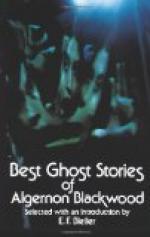“That is nothing to you, sir,” replies the newspaper man who relates the experience, and in these words expresses the true feeling about ghostly fiction, “that is nothing to you, if I also swear that it is true!”
But furthest of all in his scientific explanation—not scientifically explaining away, but in explaining the way—goes Bierce as he outlines a theory. From the diary of the murdered man he picks out the following which we may treasure as a gem:
“I
am not mad. There are colors that we cannot
see.
And—God help me!—the Damned Thing
is of
such
a color!”
This fascination of the ghost story—have I made it clear?
As I write, nearing midnight, the bookcase behind me cracks. I start and turn. Nothing. There is a creak of a board in the hallway.
I know it is the cool night wind—the uneven contraction of materials expanded in the heat of the day.
Yet—do I go into the darkness outside otherwise than alert?
It is this evolution of our sense of ghost terror—ages of it—that fascinates us.
Can we, with a few generations of modernism behind us, throw it off with all our science? And, if we did, should we not then succeed only in abolishing the old-fashioned ghost story and creating a new, scientific ghost story?
Scientific? Yes. But more,—something that has existed since the beginnings of intelligence in the human race.
Perhaps, you critic, you say that the true ghost story originated in the age of shadowy candle light and pine knot with their grotesqueries on the walls and in the unpenetrated darkness, that the electric bulb and the radiator have dispelled that very thing on which, for ages, the ghost story has been built.
What? No ghost stories? Would you take away our supernatural fiction by your paltry scientific explanation?
Still will we gather about the story teller—then lie awake o’ nights, seeing mocking figures, arms akimbo, defying all your science to crush the ghost story.
BEST GHOST STORIES
THE APPARITION OF MRS. VEAL
BY DANIEL DE FOE
THE PREFACE
This relation is matter of fact, and attended with such circumstances, as may induce any reasonable man to believe it. It was sent by a gentleman, a justice of peace, at Maidstone, in Kent, and a very intelligent person, to his friend in London, as it is here worded; which discourse is attested by a very sober and understanding gentlewoman, a kinswoman of the said gentleman’s, who lives in Canterbury, within a few doors of the house in which the within-named Mrs. Bargrave lives; who believes his kinswoman to be of so discerning a spirit, as not to be put upon by any fallacy; and who positively assured him that the whole matter, as it is related and laid down,




